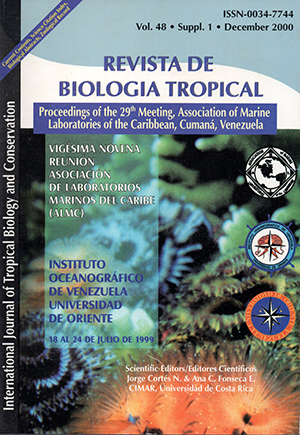Abstract
The green mussel, Perna viridis, became widespread in the northern coast of Sucre State since its arrival to Venezuela in 1993. RNA/DNA and Protein/DNA ratios were used to study the effect of starvation on its instantaneous growth. The mussels were collected in La Esmeralda and Chacopata, acclimatized in the laboratory for four weeks and maintained for another six weeks in two groups: one fed ad libitum and another with out food (this later group was later fed for two additional weeks). Protein (colorimetric method), and nucleic acid concentrations (RNA and DNA, fluorometric method with ethidium bromide) were measured in adductor muscle, digestive gland and gills. The instantaneous growth was assessed using RNA/DNA and Protein/DNA rations. These indexes were always higher in the fed organisms. Animals from Chacopata were in better physiological condition that those from La Esmeralda during the abstinence time (six weeks). Muscle was the best tissue to determine instantaneous growth. The RNA/DNA ratio is a reliable index to determine the physiological condition and instantaneous growth of this species.Comments

This work is licensed under a Creative Commons Attribution 4.0 International License.
Copyright (c) 2000 Revista de Biología Tropical
Downloads
Download data is not yet available.


